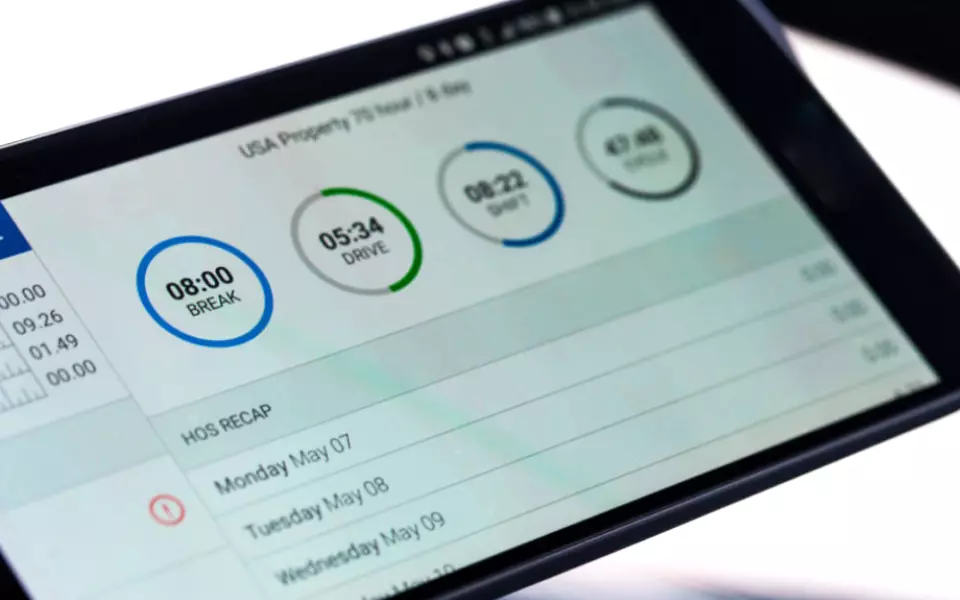The Federal Motor Carrier Safety Administration (FMCSA) imposes Hours of Service (HOS) regulations that limit the number of hours commercial truck drivers can operate their vehicles. This ensures that they get enough rest to prevent fatigue-related accidents and improve overall road safety.
It is mandated that truck drivers can operate their vehicles for a maximum of 70 hours in 8 consecutive days if they work 7 days a week or otherwise 60 hours in 7 consecutive days. In other words, they can drive a daily average of 8.5 to 10 hours while on duty.
Unfortunately, adhering to these strict regulations isn’t easy, and many drivers unintentionally exceed the time restrictions due to delivery schedules, road traffic, breakdowns, or other factors.
As such, practices like planning recap hours can enhance flexibility for truckers. Recap hours are on-duty hours from the previous duty cycle used to replenish available time in the current duty cycle.
In this article, we’ll delve deeper into recap hours, explaining their key benefits for drivers and how to calculate them. We’ll also guide readers about the best times to use recap hours and share tips to ensure compliance at all times.
What Are Recap Hours?
In trucking, recap hours refer to additional hours granted to drivers operating commercial vehicles based on the previous duty cycle on-duty hours. These hours are derived from the on-duty hours of the day prior to their current duty cycle.
In other words, it is the number of hours a driver worked 7 or 8 days before the current day depending on which HOS duty cycle they are following.

These extra hours extend the driver’s available work time, allowing them to comply with HOS regulations and at the same time maximize their productivity. It can also destress drivers on tight schedules and reduce accident risks.
It is important to note that drivers are not required to utilize recap hours and can regularly reset their duty cycle by taking 34 consecutive hours off duty to rest. When they return, they can start their 60 or 70-hour duty cycle from day 1 again.
However, when utilizing recap hours, drivers and trucking companies must maintain accurate time records to ensure compliance. We’ll explain this in more detail in the sections below and share tips to keep better track of recap hours.
How to Calculate Recap Hours?
Understanding and calculating recap hours can be confusing to most, but we will explain the process in detail and provide examples for better comprehension. Drivers and trucking companies generally calculate recap hours by accumulating the total on-duty hours from the previous 7th or 8th day.
These hours are then added onto their current balance of duty hours allowing a driver to legally operate a truck longer during their current cycle. For instance, if drivers consistently work 8 hours daily, they can add 8 recap hours to their current cycle past midnight of the 7th or 8th day. To better explain this concept, we have created a case study below.
Case Study: Calculating Recap Hours
We’ve created two tables below, each explaining how recap hours work with a 70-hour limit in 8 consecutive days and a 60-hour limit in 7 consecutive days.
Let’s assume that a trucker who’s employed by a national logistics company works within the 70-hour limit for 10 consecutive days utilizing recap hours to stay compliant with the HOS regulation.
| Days On-Duty | Hours On-Duty | Balance of Duty Hours | Recap Hours |
|---|---|---|---|
| 1 | 10 | (70 + 0 – 10) = 60 | 0 |
| 2 | 12 | (60 + 0 – 12) = 48 | 0 |
| 3 | 2 | (48 + 0 – 2) = 46 | 0 |
| 4 | 10 | (46 + 0 – 10) = 36 | 0 |
| 5 | 11 | (36 + 0 – 11) = 25 | 0 |
| 6 | 5 | (25 + 0 – 5) = 20 | 0 |
| 7 | 10 | (20 + 0 – 10) = 10 | 0 |
| 8 | 5 | (10 + 0 – 5) = 5 | 0 |
| 9 | 13 | (5 + 10 – 13) = 2 | +10 (from Day 1) |
| 10 | 10 | (2 + 12 – 10) = 4 | +12 (from Day 2) |
As you can see from the table above, due to the lack of hours remaining (balance of 6 hours on the 11th day), the driver decides to take a 34-hour rest instead to reset the duty cycle.
Let’s have a look at another case study below showing a different truck driver who’s employed by the same company complying with the 60-hour limit for 10 consecutive days.
| Day | Hours On-Duty | Balance of Duty Hours | Recap Hours |
|---|---|---|---|
| 1 | 8 | (60 + 0 – 8) = 52 | 0 |
| 2 | 8 | (52 + 0 – 8) = 44 | 0 |
| 3 | 9 | (44 + 0 – 9) = 35 | 0 |
| 4 | 7 | (35 + 0 – 7) = 28 | 0 |
| 5 | 14 | (28 + 0 – 14) = 14 | 0 |
| 6 | 0 | (14 + 0 – 0) = 14 | 0 |
| 7 | 11 | (14 + 0 – 11) = 3 | 0 |
| 8 | 7 | (3 + 8 – 7) = 4 | +8 (from Day 1) |
| 9 | 8 | (4 + 8 – 8) = 4 | +8 (from Day 2) |
| 10 | 5 | (4 + 9 – 5) = 8 | +9 (from Day 3) |
As you can see, the truck driver has a total of 8 hours remaining after the 10th day. This means that the driver can continue using recap hours to work a few more days before resetting his duty cycle.
Importance of Compliance
Whether you’re a truck driver or a trucking company, you would want to avoid any violation of HOS regulations imposed by the FMCSA. Law enforcement officers who stop drivers exceeding standard service hours can penalize them heavily or even shut down their operations. Fines typically range between $1,000 and $16,000 for non-compliance. Truckers transporting hazardous materials can be fined over $75,000.
When Should Truckers Use Recap Hours
Although recap hours give drivers more time to transport cargo, they should be used strategically. Below are the best conditions to recap hours.
- If There Are Surplus On-Duty Hours – Many drivers with excess on-duty hours during their 7/8-day cycle can use recap hours to optimize workload distribution and make their schedules more flexible.
- During Peak Periods – The best time to use recap hours is when you have high shipment volumes. Additional hours can help you meet tight delivery timelines, handle cargo, and perform routine administrative tasks more comfortably.
- When Sufficiently Rested – Well-rested drivers with surplus on-duty hours during their cycle can use recap hours to continue hauling loads. However, they must evaluate their well-being to minimize stress and prevent fatigue-related accidents.
Best Ways to Keep Track of Recap Hours
Truckers can employ various methods and use a wide variety of tools to track their recap hours. The use of these tools typically depends on their individual preferences or the company’s policy.

Using Electronic Logging Devices
Electronic Logging Devices (ELDs) are mandatory for most commercial trucks in the United States. They automatically record driving hours, rest breaks, and on-duty time, along with distance, geographic location, and engine performance.
Carriers can use them to track their driver’s HOS accurately and in real-time. Many modern ELDs are equipped with features to record and calculate recap hours automatically.
Using Mobile Apps
There is a wide variety of Android and iOS-supported mobile apps capable of recording recap hours or designed specifically for this purpose. Many have functions similar to ELDs. They also offer portability, allowing drivers to track log hours and ensure compliance with HOS regulations using smartphones or tablets.
Using Log Books
Many experienced or traditional drivers and companies use log books or paper logs to track hours, especially in situations where ELDs aren’t mandatory (for older truck models with engines manufactured on or before the year 2000).
While truckers save on ELD investment costs, this method is manual and highly susceptible to human error. Hence, some truckers using log books find record-keeping more challenging.
Using Fleet Management Software
Most modern trucking companies use powerful fleet management software to digitalize operations. These solutions can monitor, record, and manage the hours of all employed drivers.
Many of these platforms integrate with ELDs allowing them to retrieve real-time tracking data, enabling carriers to calculate recap hours and simplify compliance management for their drivers.
Tips on How to Comply With These Regulations
The tools and methods in the previous section offer convenience to truckers looking to track and manage recap hours. However, truckers must still do their due diligence to comply with state and HOS regulations. Below we discuss some highly effective tips to ensure compliance.
- Leverage Technology – Adopting advanced technological solutions like ELDs and mobile applications to reduce human errors when recording and calculating recap hours can be beneficial for accuracy and reliability.
- Self-Audit – Take your time to double-check your records. Ensure they’re accurate, current, and complete. Doing so will demonstrate your strive to comply with laws and regulations. Moreover, accurate records will help you make better decisions when leveraging additional time to haul cargo.
- Plan Ahead – Proactive planning is one of the best skills any trucker can learn and develop. It can help you manage schedules, avoid bad routes, and choose the best hauling times to minimize the impact of traffic, bad weather, and other issues. Planning ahead can also prompt drivers to ensure compliance with HOS regulations and utilize recap hours optimally.
- Retain Records – Keep updated records for at least six months to comply with FMCSA’s retention requirements. Proper record management demonstrates compliance and enables data-driven decision-making.
- Set Alerts & Notifications – You should also consider setting up alerts or notifications on your ELD or mobile application to warn you when you’re close to exceeding HOS time limits.

Get Free Course Access
If you enjoyed the article, don’t miss out on our free supply chain courses that help you stay ahead in your industry.

Andrew Lin
Co-Founder & Writer
at freightcourse
About the Author
Andrew is a multi-business owner with over 12 years of experience in the fields of logistics, trucking, manufacturing, operations, training, and education.
Being the co-founder of freightcourse has given him the ability to pursue his desire to educate others on manufacturing and supply chain topics.
Follow us